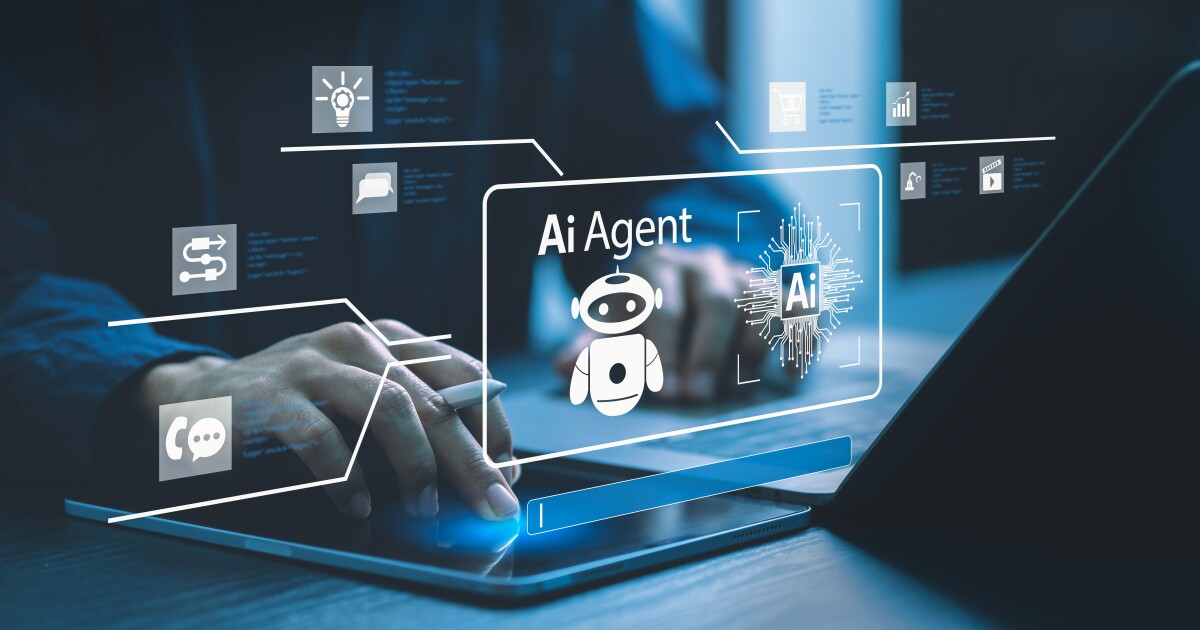Despite its relative novelty, major accounting firms have wasted no time in capitalizing on the rise of agentic AI, with technology leaders having already developed and deployed initial solutions for both client work and internal efficiencies.
While the precise definition can vary depending on who is asked, very broadly agentic AI could be described as software that is capable of at least some degree of autonomy to make decisions and interact with tools outside itself in order to achieve some sort of goal—whether booking a flight, sending a bill or buying a gift—without constant human guidance. Agents are not necessarily new, but the rise of generative AI has made them much easier to make and use, as doing so no longer requires specialized coding skills.
Daren Campbell, tax technology transformation leader with Big Four firm EY, said his firm has what is referred to internally as “an agentic AI factory” which is used to facilitate onboarding and upskill staff. The firm starts with identifying processes well-suited for agentic AI integration, then works with those responsible for the process by training them up on the agent factory to build out what they need. This has led to what he called a host of “mini agents” or “a bunch of minions” automating not entire processes end-to-end (yet) but various pieces here and there within the workflow.
“So, it’s not push button returns or anything close to that, but we… are deploying the smaller parts of the process with the intention of getting to the point where we can connect all the mini-agents to have something tackling a larger part of the process,” he said.
As just one example, EY is building out their current anomaly detection solutions, which already use AI to identify and visualize errors. Using agents, he said, will allow them to not just identify errors but propose corrections to those errors for review by a human. Something like this, said Martin Fiore, deputy vice chair of tax for EY Americas, would have been very difficult to do without the aid of AI agents.
“How do you take high volumes of data that would be impossible or not worth an individual spending time on [processing] but one you use AI and in minutes or hours do what used to take years and improve this process? The bots were more reactive, but now we’ve got something proactive. … VAT is a great example, where we have a multinational organization that operates in 120 countries. How do you take that and pull it together in a way that the human can judge against? It is a step you take to get to the next level, if we don’t we can’t get the quality that we need,” he said.
Campbell also pointed to a pilot program with several of their clients where autonomous agents tied to the company’s data actively look for regulatory changes that would affect the jurisdiction they operate from; the agent would flag the change, then notify the tax practitioners and suggest key people (e.g. external advisors, regulatory agencies) they might want to meet with to discuss the matter further. But he stressed that this is a very early development, there isn’t anything like this already in production.
Kelly Fisher, practice partner and technology specialist with top 25 firm Wipfli, said her own firm is currently experimenting on themselves with agentic AI before introducing any new solutions to clients. The most recent thing they did was create a chained series of agents that monitors and reports on legislative and regulatory changes; there is a researcher agent, a curator agent and others that, working together, researches and reports on legislative and regulatory changes for the industries they serve.
“It is for broad brand building insights, one of our goals as an organization was to [keep up with] with the pace at which we are seeing legislative changes or chatter coming out to make sure we deploy information and thought leadership to our clients, applicable specifically to our middle market clients and their insights, faster,” she said.
Asked when they deployed this solution, Fisher said about three weeks ago, speaking to the speed at which even non-coders can build and deploy AI agents.
The firm turned to agents when generative AI alone was not giving them the results they wanted. They added more documents for reference as well as refined their prompts, which did improve the bot though it still felt short of the quality they needed. So the firm then turned to multi-chained agents with specific use cases that work in concert.
“That is a pretty easy win, I would say, with semi-autonomous agents,” she said, adding that they intend to keep refining and improving the application over time.
OJ Laos, director of the AI Lab for Top 25 firm Armanino, said his own firm went through a similar journey. If one defines agentic AI as simply autonomous software, then Armanino has already been experimenting with the technology via research platforms like Microsoft’s AutoGen as well as thirty party solutions like Swarm AI and Crew AI. At its core, he said, these were “bots talking to bots, you could actually see their conversations.” They began doing this about a year ago, using them to do things like query the latest developments in the private equity world.
Fast forward to a year later, and AI models have improved both in terms of their performance as well as the ease of creating them. The old way, he said, was a lot slower and more complicated, and even then the bots would still occasionally “drop the ball between each other.” Recent improvements have led to new possibilities for process automation that would have been impractical just a short time ago.
One of the examples Laos is personally very excited about is enhancements to the firm’s audit platform to automate the document collection process. One of the most common things in audits, he said, is the big list of requests, which has usually called for manual processes to complete. The auditor would send the request list to the client, the client would have to hunt down 50 or more documents and send them to the auditor, who would then need to look at it and figure out where it fits into the larger audit process or, if it doesn’t, send it back to the client.
“This tool lets you just drop everything. If I’m the client, I’d say here’s 50 documents, go knock yourself out. The [agent] looks at them, studies what they are, figures out that this goes to that task, this goes to that auditor, this is for this use case and so on. The auditor still has to look at the evidence to see that it matches and makes sense, but it can dramatically speed that [process] up,” he said.
The next logical step past that, he said, is to have the agent assist with substantive testing, and while this remains only theoretical for now, Laos said this is what they’re eventually building towards.
Armanino has also been experimenting with OpenAI’s new Operator model, which is essentially a browser with agentic AI functions that appear to use the keyboard and mouse to do some task. Specifically, they have been seeing how well it works through RPA with the thought that, in time, it could reduce the need for custom integrations.
Even when a firm doesn’t currently have agentic AI solutions deployed, many intend to do so in the future. Avani Desai, leader of top 50 firm Schellman, said that her own firm has active R&D projects for specific agentic AI use cases both for internal efficiencies and client work.
One solution in development speaks to their cybersecurity specialization. Schellman needs to understand a client’s IT infrastructure before it can offer a proper cybersecurity solution. Right now, they wait for the client to give them this information, which they then review once they’re on site, a lengthy process that she said isn’t even technically a part of the audit itself.
“So one thing we want to focus on from an agentic AI perspective is really on the discovery section, a lot of this can really help our newer associates, even [with] a newer client, get all that information to allow us to just be smarter when we are on site,” she said, adding that they currently don’t plan to focus on testing evidence with AI, as some of their clients aren’t comfortable with that.
Schellman is also developing agentic AI for training purposes, creating a program that can act as a sort of digital worker with knowledge of SOC certification requirements and ISO standards and FedRamp compliance and payment card industry standards to help bring new staff up to speed.
“We [would] have agentic AI help by saying ‘these were past decisions’ so we can improve strategies over time… What we’re really looking at is how we can look at things from a training and awareness perspective,” she said.
Desai added that while they are intrigued by the idea of using agentic AI in compliance audits with no human intervention, “we have decided not to go down that path just yet.”
Schellman is not of the move fast and break things mindset, which explains why they are being very deliberate with their agentic AI ambitions. The ability for agentic AI to make independent decisions and adapt itself in real time, said Desai, creates an entirely new category of risk that must be considered. Humans must be concerned not only about the independent decisions of an AI agent, they must also think about how it dynamically adapts to circumstances and work to make sure it does so in a way that aligns with ethics and guardrails.
“This is why a human in the loop is so important because, at the end of the day, we want agentic AI to run autonomously, that is where you get the value from it, but you need to be really cognizant when you’re designing and developing agents that a human must be a part of that. … I also think there are so many AI policies around AI safety and ethics and governance: that also needs to be part of the development process. At the end of the day we won’t have [as much] human oversight once these autonomous agents start working, but I think you can identify risk and mitigate that risk early in the development lifecycle,” she said.


 Economics1 week ago
Economics1 week ago
 Economics1 week ago
Economics1 week ago
 Economics6 days ago
Economics6 days ago
 Finance1 week ago
Finance1 week ago
 Economics1 week ago
Economics1 week ago
 Blog Post6 days ago
Blog Post6 days ago
 Personal Finance6 days ago
Personal Finance6 days ago
 Finance6 days ago
Finance6 days ago












